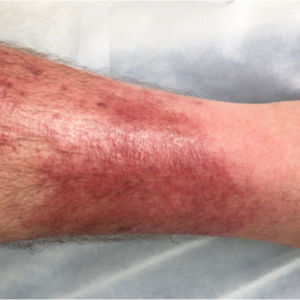
What is cellulitis
Cellulitis is an acute skin infection caused by the bacteria staphylococcus or streptococcus, usually affecting the lower limbs. Cellulitis mainly affects the epidermis and the dermis. The skin disease usually causes pain, is noticeable by a feeling of warmth or by a rapidly spreading erythema (reddening of the skin) and/or oedema (bruising). If the infection is severe, fever may also occur and there may be enlargement of the regional lymph nodes. Cellulitis is usually treated with antibiotics.
What are the different stages of cellulitis?
Doctors usually differentiate between erysipelas and phlegmon. Erysipelas, the so-called erysipelas, is a special form of cellulitis. Erysipelas spreads superficially on the skin, but also penetrates into the lower layers of the skin and leads to inflammation there, which can have life-threatening consequences. Erysipelas is caused by streptococci.
Phlegmon is a spreading inflammation of the subcutis caused by staphylococci. It can extend from the muscle skin to the tendon tissue and form extensive necroses. In addition to erysipelas and phlegmon, cellulitis can also become purulent (pus-filled) in some cases, but this abscess cannot be drained. This is a particularly severe course of infection.
What causes cellulitis?
The triggers for cellulitis are either the so-called Streptococcus pyogenes (group A streptococci) or Staphylococcus aureus, which usually enter the body through impaired skin barrier and lead to a rapidly spreading skin infection. Externally, cellulitis is noticeable by an open wound or a skin abscess. In rarer cases, animal bites or diving injuries can also cause cellulitis. In particular, skin damage such as minor or major skin injuries or a fungal infection increase the risk of cellulitis. But lymphoedema can also increase the risk of developing cellulitis, as doctors have found that lymph positively promotes bacterial growth. Furthermore, there are the following risk factors that can contribute to the development of cellulitis:
- a disturbed or weakened immune system: Doctors have found out that especially older people, diabetics, AIDS patients or people who have herpes tend to develop cellulitis,
- Diseases that affect blood circulation in the lower limbs, such as lymphoedema.
What are the symptoms of cellulitis?
Cellulitis most often occurs on one side of a leg. Warm, red and painful areas of skin can be the first signs of cellulitis. Purulent secretions are not typical of cellulitis. However, one or more pustules, boils or abscesses may appear. If blisters with a clear fluid have formed, this can indicate a particularly severe course. In addition to these external manifestations on the skin, the following other symptoms may also occur:
- Fever and even chills,
- Heart palpitations (tachycardia),
- Headache,
- low blood pressure (hypotension),
- delirium in the case of a severe infection
If the symptoms increase rapidly and there is skin detachment due to blistering, this may indicate a life-threatening infection.
How is cellulitis diagnosed?
If cellulitis is suspected, a doctor should always be consulted so that treatment can begin. Cellulitis is usually diagnosed by a physical examination of the affected skin areas. Especially in immunocompromised patients who show signs of a severe infection, blood cultures can also be taken to identify the germs that cause the disease.
How is cellulitis treated?
In the case of cellulitis without pus or in the case of a particularly severe course of infection, antibiotics are usually used, which are taken orally. It is important to observe the course of the disease for the first 48 hours. If the symptoms do not subside during this period, hospitalisation or parenteral treatment may be necessary to reduce the risk of sepsis.
The administration is usually continued until the cellulitis has clinically subsided. In most patients, this takes less than a week. The treatment with antibiotics can be supported by immobilising or elevating the corresponding part of the body. Cooling wet bandages can not only relieve the pain but also reduce the oedema.
What are the chances of healing cellulitis?
Cellulitis usually heals quickly with antibiotic treatment. However, sometimes local abscesses can form, which again need to be treated with incision and drainage. As recurrent skin inflammation can occur in some cases, the following preventive measures should be taken:
- in the case of circulatory disorders of the legs, ensure that the blood circulation is improved,
- optimise blood sugar levels in diabetic patients,
- ensure good hygiene and avoid chapping of the feet.
